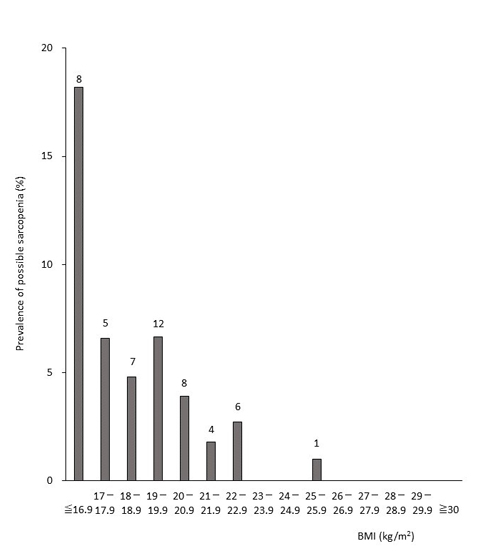Analysis of medical data from around 1800 65-year-old residents of Kobe, a large Japanese city, has shown that at least 3% have possible sarcopenia*1, revealing that the risks are higher in those who are underweight and don’t exercise enough. This research was carried out by Project Professor TAMORI Yoshikazu (Division of Creative Health Promotion) et al. at the Kobe University Graduate School of Medicine. The researchers analyzed each participant’s Specific Health Checkup results as well as data on their calf circumference and handgrip strength (the Specific Health Checkup is offered to all public medical insurance subscribers in Japan aged 40-74, and aims to prevent lifestyle-related diseases).
In addition, it was revealed that those with possible sarcopenia exhibited a higher degree of frailty*2 even though their Specific Health Checkup results were normal. Signs of frailty include decreased activity and exercise levels, decreased cognitive function and a tendency to stay indoors. Frailty is an early indicator that the person may become bedridden and require nursing care in the future.
The results of this study have highlighted that sarcopenia cannot be diagnosed through the standard health checkups in place in Japan, indicating the need for a test to identify sarcopenia from the beginning of old age (65) in order to prevent people becoming bedridden and requiring nursing care in the future.
These results were published in the online edition of Geriatrics and Gerontology International on June 23, 2021.
Main points
- Analysis of data on approximately 1800 citizens of Kobe city aged 65 revealed that around 3% have possible sarcopenia.
- Possible sarcopenia was rarely found in conjunction with obesity.
- Compared to those without possible sarcopenia, those with showed a significant tendency to be frail, even if their results for the Specific Health Checkup were more favorable.
- Being underweight and insufficient physical activity are risk factors for sarcopenia.
- These results indicate that in addition the regular post-65 health checkups, it is also necessary to measure elderly people’s muscle strength and muscle mass in order to prevent the need for nursing care in the future.
Research Background
Frailty can serve as an early indication that a person will require nursing care and has received attention as an important issue when considering healthy life expectancy in our increasingly aging society. Frailty is accompanied by decline in physical and cognitive functions, as well as muscle deterioration (sarcopenia) resulting from old age and weight loss.
Despite this, there is a lack of detailed information regarding the prevalence of sarcopenia because diagnosis still requires specialist measuring equipment, which makes it difficult to diagnose at a regular clinic or during a medical checkup.
A new set of diagnostic criteria was introduced by the Japanese Association on Sarcopenia and Frailty (JASF) in November 2019, making it comparatively easier to diagnose possible sarcopenia.
To reduce frailty and the need for nursing care in elderly people it is vital to understand how many people at the beginning of old age (65 years old) have possible sarcopenia and to illuminate the status of their health.
Research Methodology
This study examined data from around 1800 Kobe citizens aged 65, who were all members of Japan’s National Health Insurance. By applying JASF’s new criteria (Figure 1), the researchers were able to determine the prevalence of possible sarcopenia from data on participants’ calf circumference and handgrip strength. At the same time, the researchers were also able to assess the everyday level of physical and cognitive function in participants with possible sarcopenia using their answers to the Specific Health Checkup questionnaire.

Based on the revised diagnostic criteria introduced in 2019, the research group assessed possible sarcopenia in approximately 1800 Kobe citizens aged 65 who had taken the Specific Health Check-up.
It was found that around 3% had possible sarcopenia, the majority of whom were not obese. It was found that the thinner the participant was the more likely they were to have possible sarcopenia (Figure 2). Those with possible sarcopenia demonstrated more favourable results on the Specific Health Check-up than those without, however their responses to the check-list to evaluate physical and mental function indicated decline in categories relating to everyday activity levels, exercise ability, nutrition, seclusion and cognitive function (Table 1).
From the results of an analysis conducted at the same time, the researchers estimated that possible sarcopenia is caused by weight loss and insufficient exercise.

The prevalence rate of possible sarcopenia increases the lower the subject’s BMI is, and was rarely found in conjunction with obesity (A BMI score of over 25 indicates obesity. Numbers above the bars indicate subjects.)

This table shows the percentage of participants who answered ‘Yes’ to the respective questions. These statistics reveal the difference between the two groups.
Research Significance and Further Research
The results of this research conducted in Kobe, a representative large city of Japan, showed that even among the young elderly (aged 65) at least 3% have possible sarcopenia. These results provide initial evidence that mental and physical function is declining across a wide range of areas of these people’s daily lives, even in cases where there were no causes for concern in the results of Specific Health Checkup, which was designed to prevent lifestyle diseases.
Early intervention in sarcopenia cases can have beneficial effects. With this in mind, it would be desirable for elderly people to be offered a test to assess sarcopenia in addition to the current Specific Health Checkup. This would enable future reductions in the number of people who are bedridden and require nursing care.
Supplementary Explanation
- 1. Sarcopenia
- A condition characterized by an age-dependent decline in muscle mass, activity levels and physical function. It reduces the individual’s healthy life expectancy and can result in falls, broken bones, difficulty walking and immobility. An individual’s muscle mass begins to decline after reaching its peak between the ages 25 and 30, and this decline accelerates after the age of 65. However, it is possible to delay the progression of sarcopenia through exercise training.
- 2. Frailty
- Frailty is characterized by age-related deterioration of mental and physical health and a tendency towards being housebound and withdrawing from society. It is the stage between good health and requiring nursing care. However, frailty is a reversible condition and can be ameliorated by eating a balanced diet, appropriate exercise and social engagement. Sarcopenia is one of the major causes of frailty.
Journal Information
- Title
- “Clinical features of 65-year-old individuals in Japan diagnosed with possible sarcopenia based on the Asian Working Group for Sarcopenia 2019 criteria”
- DOI
- 10.1111/ggi.14182
- Authors
- Hiroshi Miura1, Kazuhiko Sakaguchi2, Wataru Ogawa1, Yoshikazu Tamori1,3*
1. Division of Diabetes and Endocrinology, Department of Internal Medicine, Kobe University Graduate School of Medicine.
2. Division of General Internal Medicine, Department of Internal Medicine, Kobe University Graduate School of Medicine.
3. Division of Creative Health Promotion, Department of Social/Community Medicine and Health Science, Kobe University Graduate School of Medicine.
* Corresponding author
- Journal
- Geriatrics and Gerontology International











